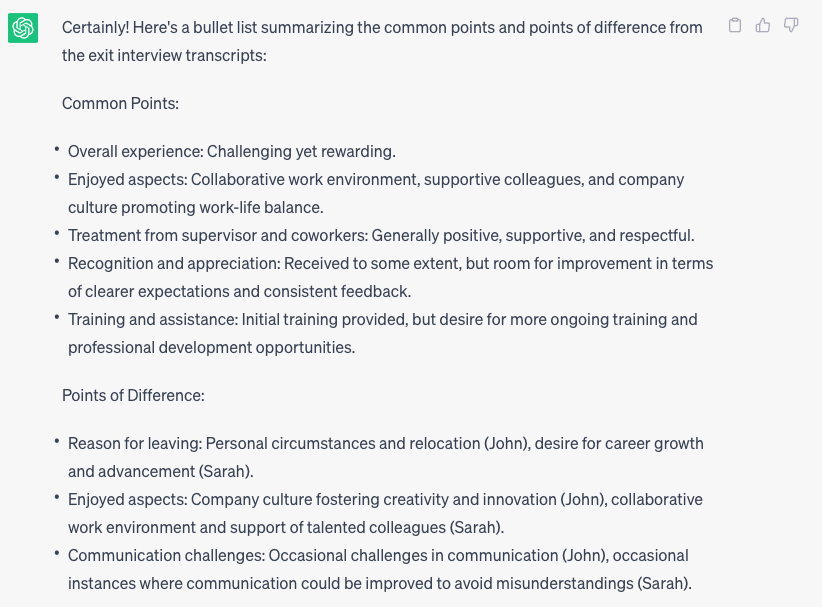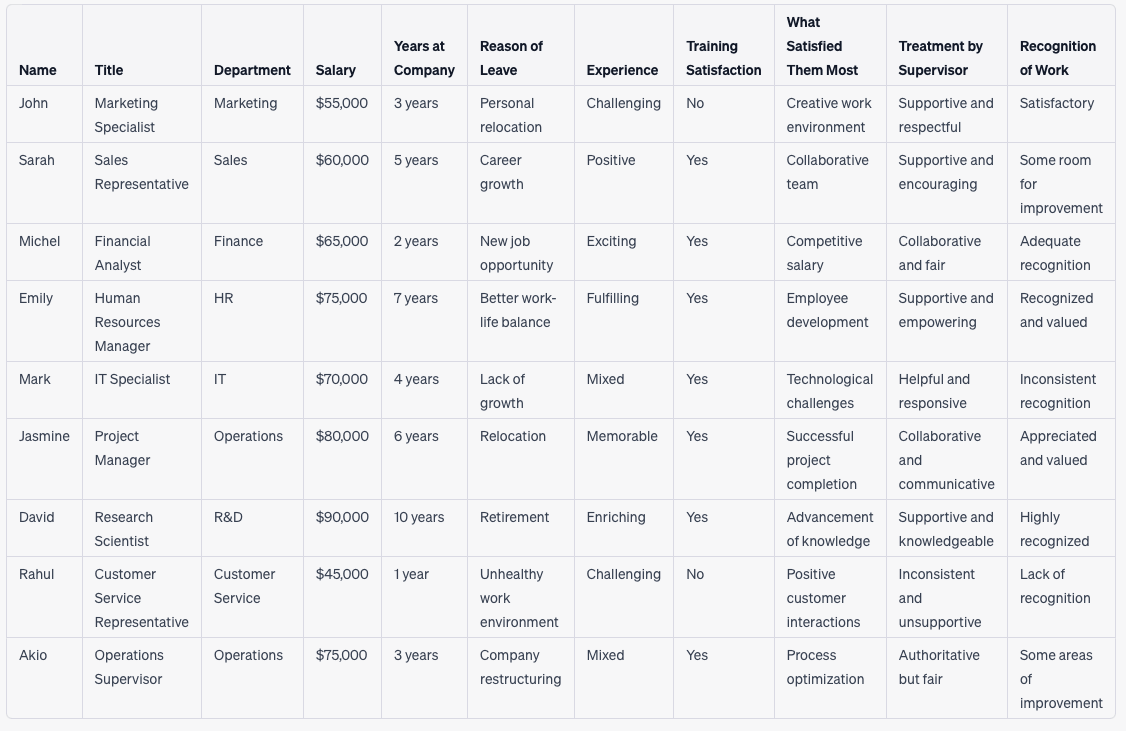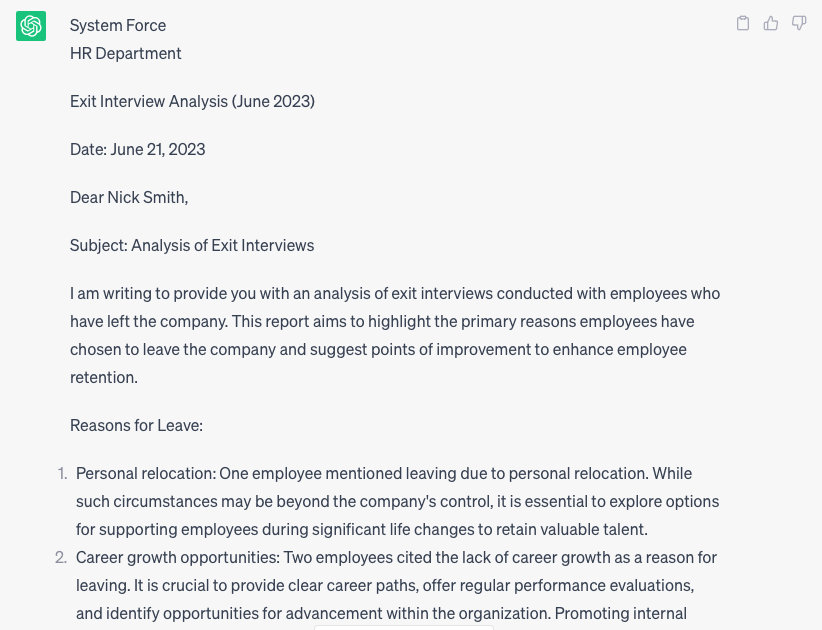Create exit interview reports in minutes using ChatGPT
An exit interview report is a document summarizing the feedback from employees leaving a company. It provides insights into their experiences, reasons for departure, and suggestions for improvement, helping organizations refine their employee retention strategies and work culture.

Did you know that ChatGPT can be a very helpful tool in your quest for better retention rates and the improvement of corporate culture? As an HR professional or SMB owner, you need to organize your exit interviews in a way that, in combination with AI, can yield valuable outcomes.
Exit interviews play a crucial role in gaining valuable insights into employee turnover, helping organizations improve their retention strategies and foster a positive workplace culture.
However, traditional methods of analyzing exit interview data can be time-consuming, subjective, and limited in scope.
Let’s explore how ChatGPT, an AI-powered language model, can support your exit interview efforts by creating engaging reports for your manager.
Contents
Why to use ChatGPT for your exit interview reports?
Using ChatGPT for creating reports based on exit interviews data can greatly benefit HR professionals.
ChatGPT’s capabilities in data analysis, natural language understanding, and summarization allow it to efficiently process and interpret the data, saving valuable time and effort.
By leveraging ChatGPT’s abilities to identify patterns, trends, and key insights, HR professionals can gain a deeper understanding of employee sentiments, reasons for departure, and areas for improvement.
The generated reports can be concise, yet comprehensive, providing a valuable overview of the exit interviews data.
This, in turn, empowers HR professionals to make data-driven decisions, develop targeted retention strategies, and drive improvements in employee satisfaction and engagement.
Ultimately, ChatGPT’s support in report creation based on exit interviews data enhances the HR professional’s ability to extract meaningful insights and take informed actions to strengthen the organization’s workforce.
Related: Exit interview questions and answers
Analyzing Exit Interview Data
Conducting numerous exit interviews can be daunting when it comes to analyzing them. Fortunately, it is easier than ever to write down your notes and transform them into effective reports.
There are many tools available to help you with this. Microsoft Office and Google Docs, for example, can assist you in taking notes and providing reports to your managers. However, you need to be proficient with these software programs to take full advantage of all the available options they offer.
In addition, you can use online tools easier to manage like SurveyMonkey or Google Forms to do your work in less time.
If you are looking for something quick and almost effortless, you can use AI tools to extract your outcomes and take action immediately.
Workable’s new AI features, for example, can help you by suggesting questions and taking automated notes during exit interviews. All you need to do is fit them to your own tone, and use them to create efficient results.
Using ChatGPT for exit interviews analysis
Here, we are going to use ChatGPT to show you how easy you can build a report based on the feedback from exit interviews.
First gather all the answers (notes or transcripts) given to the same question for all participants in a Google doc or your preferred desktop app. Go to ChatGPT and use this prompt before adding your text:
The below transcripts contain answers to` [interview question]. Could you please create a bullet list of similarities and differences for me?

Check the answer and copy the information contained as they are important for your report.
If you want to delve deeper, you can incorporate details about their salary, role, and department, even without cleaning properly your data, and request ChatGPT to generate a table for you containing concise responses to all your inquiries.
For example you can use this prompt:
Can you build a table for me based on the given data containing employee names, their department, their role, their wage, their years at the company, the reason of leave (between 1-6 words), overall experience (1-6 words) Training satisfaction (yes or no), what satisfied them the most (1-6 words), treatment by supervisor (1-6 words), and recognition of work (1-6 words)?
And voilà…

You can adjust your query depending on your company needs.
Building reports from exit interviews
Now you have all the critical information for your record. If your manager wants to build a report and email them, you can continue using ChatGPT:
Could you please build a report for my HR manager summarizing the reasons for leave and including points for improvement based on the above data? My name is Anna Morrison, I’m an HR assistant, my company name is System Force, and my HR manager is named Nick Smith.
Based on our sample data we received this answer.

Subject: Exit Interview Analysis
System Force, HR Department
Date: June 21
Dear Nick Smith,
I am writing to provide you with an analysis of employee exit interview based on the reasons for leave obtained from exit interviews. This report aims to highlight the primary reasons employees have chosen to leave the company and suggest points of improvement to enhance employee retention.
Reasons for Leave:
- Personal relocation: One employee mentioned leaving due to personal relocation. While such circumstances may be beyond the company’s control, it is essential to explore options for supporting employees during significant life changes to retain valuable talent.
- Career growth opportunities: Two employees cited the lack of career growth as a reason for leaving. It is crucial to provide clear career paths, offer regular performance evaluations, and identify opportunities for advancement within the organization. Promoting internal mobility and professional development programs can help address these concerns.
- New job opportunity: One employee mentioned leaving for a new job opportunity. Conducting stay interviews with employees and actively identifying their career aspirations can help identify and address any potential flight risks proactively.
- Work-life balance: One employee cited the need for better work-life balance. Promoting and fostering a healthy work-life balance, such as implementing flexible work arrangements or offering employee wellness programs, can contribute to improved job satisfaction and retention.
- Unhealthy work environment: One employee cited an unhealthy work environment as the reason for leaving. It is crucial to assess and address any issues related to workplace culture, communication, and employee well-being to ensure a positive and inclusive work environment for all employees.
Points of Improvement:
Based on the analysis, here are some suggested points of improvement to enhance employee retention:
- Enhance career development opportunities: Create clear career paths, provide regular feedback and performance evaluations, and offer training and development programs to support employees’ professional growth.
- Promote work-life balance: Implement policies and programs that support work-life balance, such as flexible work arrangements, wellness initiatives, and promoting a healthy work environment.
- Foster a positive work culture: Encourage open communication, collaboration, and recognition to create a supportive and inclusive work environment.
- Conduct stay interviews: Regularly engage with employees to understand their aspirations, concerns, and needs, and address any potential flight risks proactively.
- Strengthen talent retention strategies: Implement programs and initiatives to recognize and reward employees’ contributions, provide competitive compensation and benefits, and foster a positive employee experience.
By addressing these areas of improvement, we can enhance employee satisfaction, engagement, and ultimately improve employee retention within the organization.
Please let me know if you require any further information or assistance in implementing these suggestions.
Thank you for your attention to this matter.
Sincerely,
Anna Morisson
HR Assistant
You can edit this report based on your experience, knowledge, and the needs of your organization.
Briefly, we saw that ChatGPT can assist you in writing a comprehensive report for your manager by instantly providing the most useful data such as participation rates, main reasons for exiting, areas of improvement, and ideas for conducting comparative research, if necessary, to compare your employee exit data with industry benchmarks.
Additionally, ChatGPT can help you continue your analysis by providing information on employee retention rates, engagement levels, and turnover costs based on the data you will share.
In short, save time creating a detailed and valuable exit interview report using ChatGPT, focus on how you and your organization can act to boost retention and reduce staff turnover. Take the feedback seriously and start working on a better future for your company and its culture.
Frequently asked questions
- How can ChatGPT aid in creating exit interview reports?
- ChatGPT can process and interpret exit interview data, identifying patterns, trends, and key insights. It can generate concise yet comprehensive reports, thus aiding HR professionals in creating targeted retention strategies.
- Is it challenging to use ChatGPT for exit interview analysis?
- Not at all. All you need is to provide clear prompts and your interview data. ChatGPT will analyze the information and create bullet points, tables, or comprehensive reports based on your needs.
- How accurate is the analysis provided by ChatGPT?
- ChatGPT's analysis is based on the data you provide. It can accurately identify patterns and trends, though human validation is recommended to ensure the insights align with the context and organizational values.
- Can ChatGPT be used for other HR tasks besides exit interview reports?
- Absolutely. ChatGPT can assist with various HR tasks, such as drafting emails, creating meeting notes, writing job descriptions, and generating employee engagement survey reports.
- Does ChatGPT replace the need for HR professionals?
- No, ChatGPT doesn't replace HR professionals but enhances their work efficiency. While it can handle tasks like creating reports or drafting emails, human insight, empathy, and decision-making are crucial for effective HR management.




